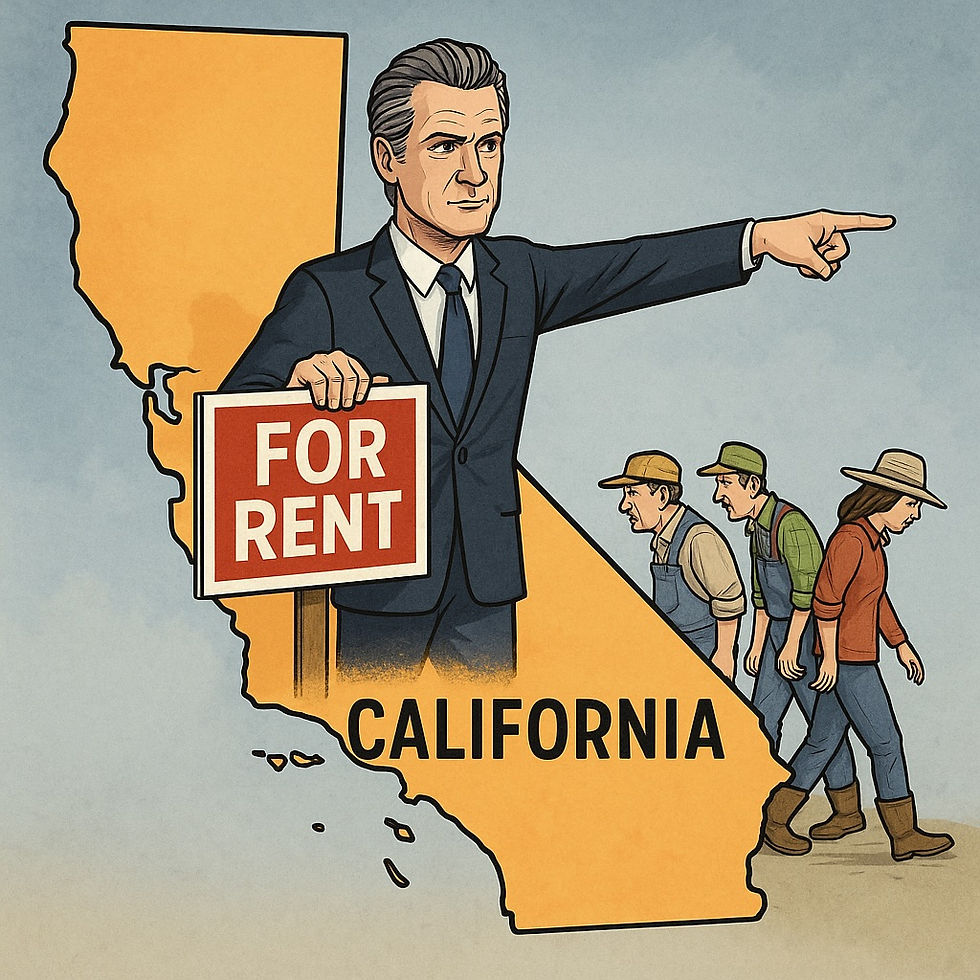California’s Silent Transformation: From Farmland to Tenant State
- lhpgop
- Aug 20
- 3 min read

The False Crisis Narrative
California’s leaders continue to present two urgent crises to the public: a water economy crisis and a housing shortage.The story goes that the state must restrict farmland irrigation to “save the environment” and rezone vast swathes of land for housing to “make life affordable.”
But beneath the surface, these narratives serve as political and financial instruments. They are not just about water conservation or affordable housing — they are about transforming California’s economic and social structure.
The Water Weapon: Devaluing the Land
Water has become the tool of choice for restructuring land ownership. Through restricted surface water allocations and the enforcement of the Sustainable Groundwater Management Act (SGMA), farmers are being pushed into financial distress.
Reduced yields from diminished water allocations.
Increased costs from pumping fees, energy bills, and regulatory compliance.
Restricted financing as banks reclassify farms under probationary basins as “high risk.”
The result: once-productive farmland is being quietly devalued. For many landowners, selling becomes the only option — often at prices well below the land’s true potential.
From Farmer to Financier
Who steps in when farmers are forced out? Developers, real estate investment trusts (REITs), hedge funds, and politically connected investors.
The math is staggering: farmland that might sell for $15,000–$30,000 per acre under regulatory stress can, once rezoned for residential development, be worth $500,000 to $3 million per acre.
Counties favor this transformation too, since property tax revenues from subdivisions far exceed those from agriculture. What looks like a “water policy” problem is, in practice, a massive land transfer scheme.
The Cost: America’s Food Basket Shrinks
California’s Central Valley produces a third of America’s vegetables and two-thirds of its fruits and nuts. Removing 500,000 acres of farmland from production isn’t just a regional adjustment — it is a direct hit to the national food supply.
Higher food prices for staples like lettuce, tomatoes, and citrus.
Increased import dependence on Mexico, Chile, and Turkey.
Loss of food sovereignty. Once California’s farmland is paved over, it is gone forever.
This is not just a farming issue; it is a national security risk.
The Tenant Society Emerges
Rezoned farmland does not become affordable single-family housing for working families. It becomes high-density rentals or tightly controlled HOAs, often owned and operated by large financial institutions.
The result is a deliberate shift:
Independent farmer → dispossessed seller.
Working family → permanent renter.
Corporate landlords benefit, municipalities collect higher taxes, but ordinary Californians lose the possibility of property ownership as a path to stability and upward mobility.
Immigration as the Renter Base
California’s permissive immigration stance ensures a steady supply of residents who, legally or financially, cannot buy homes. Millions of migrants — many without citizenship or permanent residency — are channeled into the rental market.
This creates a guaranteed, permanent tenant class:
Families who will never be eligible for property ownership.
Populations politically dependent on subsidies, vouchers, and landlords.
A built-in customer base for corporate rental empires.
Housing scarcity, then, is not about lack of units. It is about designing a society of tenants, not owners.
The Urban Fallout: Ghettos Old and New
As shiny new tracts rise on former farmland, investment and middle-class families migrate outward. Older neighborhoods — South Los Angeles, Oakland’s flatlands, parts of Fresno and Stockton — are left behind.
These areas are starved of reinvestment, slipping further into disrepair. The cycle repeats: displace, decay, redevelop — but under corporate ownership, not community renewal.
Cui Bono? Who Benefits?
When viewed through the lens of realpolitik, the winners and losers become clear:
Winners: developers, financiers, REITs, counties chasing tax revenue.
Losers: farmers, working families, the U.S. food supply, and the ideal of property-owning democracy.
What is being built is not a greener, more affordable California. It is a tenant state, where ownership is concentrated in institutions, food is imported from abroad, and the working class is locked into dependency.
Conclusion: A Strategic Choice
California’s farmland is not just dirt. It is a strategic resource, as critical to America’s independence as oil reserves or rare earth minerals. To sacrifice it under the guise of a “water crisis” or “housing affordability” is to exchange long-term food and economic sovereignty for short-term profit and political control.
The path forward should be clear:
Protect farmland as a national security asset.
Incentivize rehab of existing housing stock instead of farmland conversion.
Restrict the financialization of housing that traps families in permanent tenancy.
California’s future — and America’s food supply — depend on whether we allow the “water economy” narrative to mask what is really happening: the dismantling of ownership culture in favor of a managed tenant society.




Comments